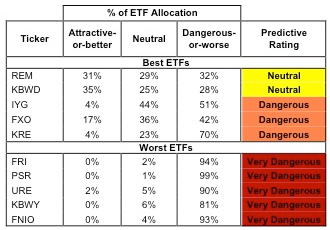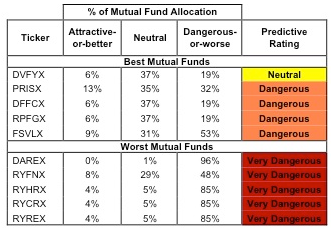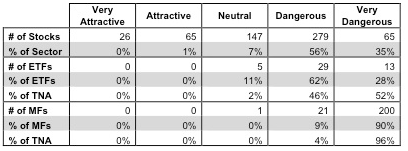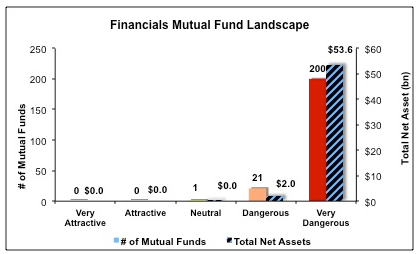The Financials sector ranks last out of the ten sectors as detailed in my sector roadmap. It is the only sector to earn my Very Dangerous rating, which is based on aggregation of ratings of 47 ETFs and 222 mutual funds in the Financials sector as of July 13, 2012.
Figures 1 and 2 show the five best and worst-rated ETFs and mutual funds in the sector. Not all Financials sector ETFs and mutual funds are created the same. The number of holdings varies widely (from 20 to 506), which creates drastically different investment implications and ratings. The best ETFs and mutual funds allocate more value to Attractive-or-better-rated stocks than the worst ETFs and mutual funds, which allocate too much value to Neutral-or-worse-rated stocks.
To identify the best and avoid the worst ETFs and mutual funds within the Financials sector, investors need a predictive rating based on (1) stocks ratings of the holdings and (2) the all-in expenses of each ETF and mutual fund. Investors need not rely on backward-looking ratings.
Investors should not buy any Financials ETFs or mutual funds because none get an Attractive-or-better rating. If you must have exposure to this sector, you should buy a basket of Attractive-or-better rated stocks and avoid paying undeserved fund fees. Active management has a long history of not paying off.
Figure 1: ETFs with the Best & Worst Ratings – Top 5

Best ETFs exclude ETFs with TNA’s less than 100 million for inadequate liquidity.
Sources: New Constructs, LLC and company filings
7 ETFs are excluded from Figure 1 because their total net assets (TNA) are below $100 million and do not meet our liquidity standards.
Figure 2: Mutual Funds with the Best & Worst Ratings – Top 5 
Best mutual funds exclude funds with TNA’s less than 100 million for inadequate liquidity.
Sources: New Constructs, LLC and company filings
iShares FTSE NAREIT Mortgage REITs Index Fund (REM) is my top-rated Financials ETF and Davis Series, Inc: David Financial Fund (DVFYX) is my top-rated Financials mutual fund. Both earn my Neutral rating.
iShares FTSE NAREIT Industrial/Office Capped Index Fund (FNIO) is my worst-rated Financials ETF and Rydex Series Funds: Real Estate Fund (RYREX) is my worst-rated Financials mutual fund. Both earn my Very Dangerous rating and should be avoided.
Figure 3 shows that 91 out of the 582 stocks (only 1% of the total net assets) held by Financials ETFs and mutual funds get an Attractive-or-better rating. Due to the low allocation of total net assets to Attractive-or-better-rated stocks, no ETFs or mutual funds in the Financials sector are worth buying. In fact, 90% of all Financials Mutual funds earn my Very Dangerous Rating and should be sold.
The takeaway is: too many Financial sector mutual fund managers and ETFs are picking the wrong stocks. Their fees are undeserved, no matter how low..
Figure 3: Financials Sector Landscape For ETFs, Mutual Funds & Stocks
Sources: New Constructs, LLC and company filings
As detailed in “Cheap Funds Dupe Investors”, the fund industry offers many cheap funds but very few funds with high-quality stocks, or with what I call good portfolio management.
Investors need to avoid all Financials ETFs and mutual funds, only 5 ETFs and 1 mutual fund earns my Neutral rating and should be held. All of ETFs and mutual funds should be sold. Investors seeking exposure to the Financials sector should focus on the 85 stocks in the Financials sector that earn an Attractive-or-better rating.
Credit Acceptance Corp (CACC) is one of my favorite stocks held by Financials ETFs and mutual funds and earns my Very Attractive rating. CACC has a proven track record of effective capital stewardship with a return on invested capital (ROIC) of 28% in 2011, which places the company in the 94th percentile of all Russell 3000 companies. CACC is not only a good company; it is also an attractive stock due to the market’s pessimistic view of future cash flows. The company’s current stock price (~$92.16) implies that after-tax profits (NOPAT) will permanently decrease by 10%. This seems unlikely given that the company has increased its profits by an average of 35% over the past six years. Low expectations and strong historical performance make CACC an excellent long candidate.
Health Care REIT, Inc. (HCN) is one of my least favorite stocks held by Financials ETFs and mutual funds and earns my Very Dangerous rating. In the worst sector, HCN is one of the worst stocks. HCN has misleading earnings – its economic earnings are negative and declining while its reports accounting earnings are positive and increasing. Only twice during the 14 years in my model has the company generated positive economic earnings, with 2008 being the most recent period. Not only is HCN not profitable, it is also overvalued. To justify its current stock price (~$59.56), the company must increase profits by 14.1% compounded annually for 34 years. That is a lot of future value creation for a company that has mostly destroyed value. Investors should avoid this stock.
Figures 4 and 5 show the rating landscape of all Financials ETFs and mutual funds.
Figure 4: Separating the Best ETFs From the Worst ETFs 
Sources: New Constructs, LLC and company filings
Figure 5: Separating the Best Mutual Funds From the Worst Mutual Funds 
Sources: New Constructs, LLC and company filings
Disclosure: I own CACC. I receive no compensation to write about any specific stock, sector or theme.
- English (UK)
- English (India)
- English (Canada)
- English (Australia)
- English (South Africa)
- English (Philippines)
- English (Nigeria)
- Deutsch
- Español (España)
- Español (México)
- Français
- Italiano
- Nederlands
- Português (Portugal)
- Polski
- Português (Brasil)
- Русский
- Türkçe
- العربية
- Ελληνικά
- Svenska
- Suomi
- עברית
- 日本語
- 한국어
- 简体中文
- 繁體中文
- Bahasa Indonesia
- Bahasa Melayu
- ไทย
- Tiếng Việt
- हिंदी
Best And Worst ETFs (And Mutual Funds): Financials Sector
Published 07/16/2012, 01:10 AM
Updated 07/09/2023, 06:31 AM
Best And Worst ETFs (And Mutual Funds): Financials Sector
3rd party Ad. Not an offer or recommendation by Investing.com. See disclosure here or
remove ads
.
Latest comments
Install Our App
Risk Disclosure: Trading in financial instruments and/or cryptocurrencies involves high risks including the risk of losing some, or all, of your investment amount, and may not be suitable for all investors. Prices of cryptocurrencies are extremely volatile and may be affected by external factors such as financial, regulatory or political events. Trading on margin increases the financial risks.
Before deciding to trade in financial instrument or cryptocurrencies you should be fully informed of the risks and costs associated with trading the financial markets, carefully consider your investment objectives, level of experience, and risk appetite, and seek professional advice where needed.
Fusion Media would like to remind you that the data contained in this website is not necessarily real-time nor accurate. The data and prices on the website are not necessarily provided by any market or exchange, but may be provided by market makers, and so prices may not be accurate and may differ from the actual price at any given market, meaning prices are indicative and not appropriate for trading purposes. Fusion Media and any provider of the data contained in this website will not accept liability for any loss or damage as a result of your trading, or your reliance on the information contained within this website.
It is prohibited to use, store, reproduce, display, modify, transmit or distribute the data contained in this website without the explicit prior written permission of Fusion Media and/or the data provider. All intellectual property rights are reserved by the providers and/or the exchange providing the data contained in this website.
Fusion Media may be compensated by the advertisers that appear on the website, based on your interaction with the advertisements or advertisers.
Before deciding to trade in financial instrument or cryptocurrencies you should be fully informed of the risks and costs associated with trading the financial markets, carefully consider your investment objectives, level of experience, and risk appetite, and seek professional advice where needed.
Fusion Media would like to remind you that the data contained in this website is not necessarily real-time nor accurate. The data and prices on the website are not necessarily provided by any market or exchange, but may be provided by market makers, and so prices may not be accurate and may differ from the actual price at any given market, meaning prices are indicative and not appropriate for trading purposes. Fusion Media and any provider of the data contained in this website will not accept liability for any loss or damage as a result of your trading, or your reliance on the information contained within this website.
It is prohibited to use, store, reproduce, display, modify, transmit or distribute the data contained in this website without the explicit prior written permission of Fusion Media and/or the data provider. All intellectual property rights are reserved by the providers and/or the exchange providing the data contained in this website.
Fusion Media may be compensated by the advertisers that appear on the website, based on your interaction with the advertisements or advertisers.
© 2007-2024 - Fusion Media Limited. All Rights Reserved.
